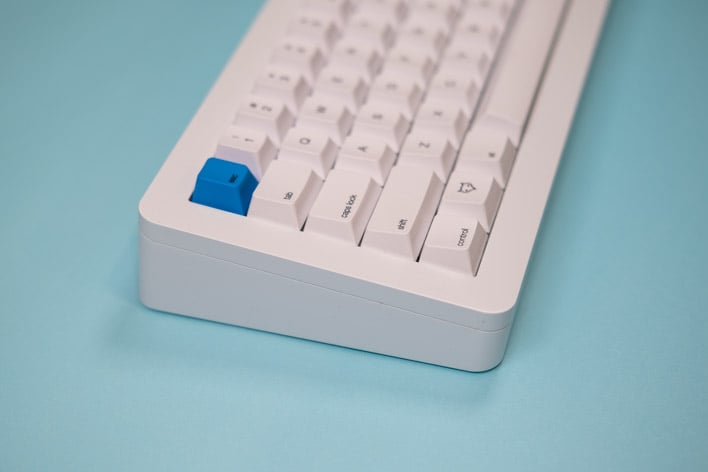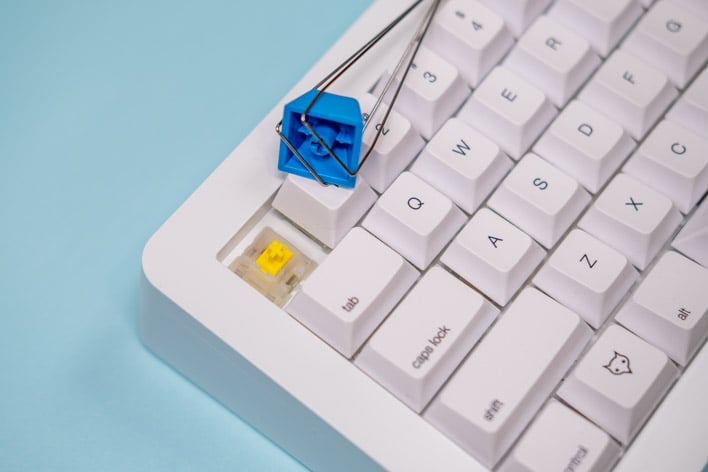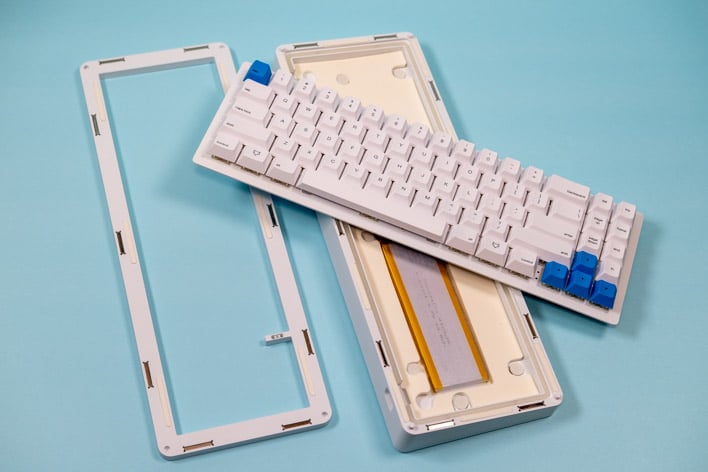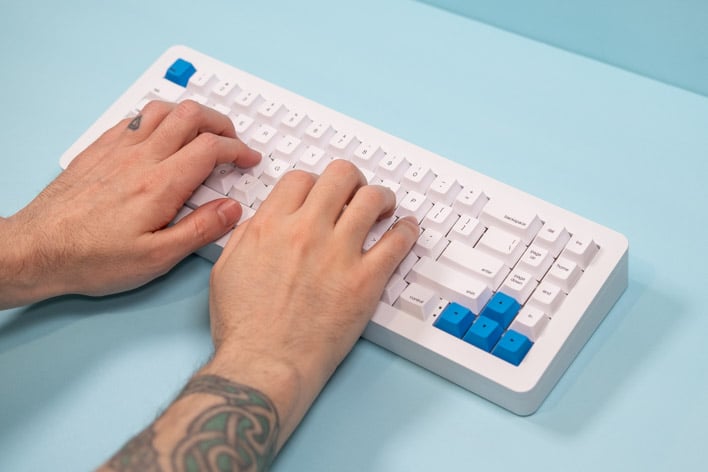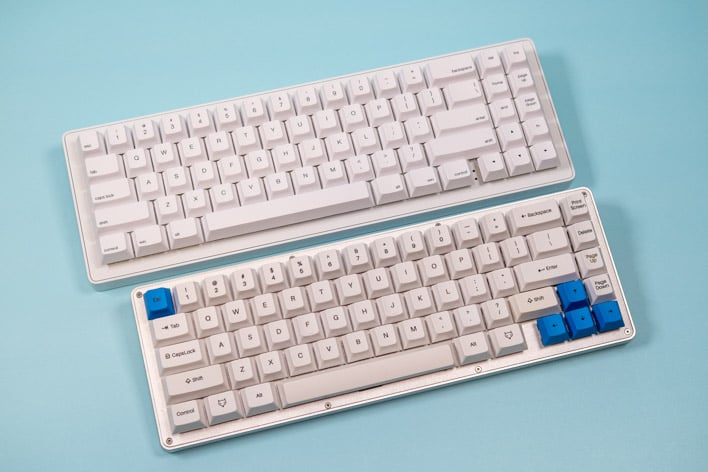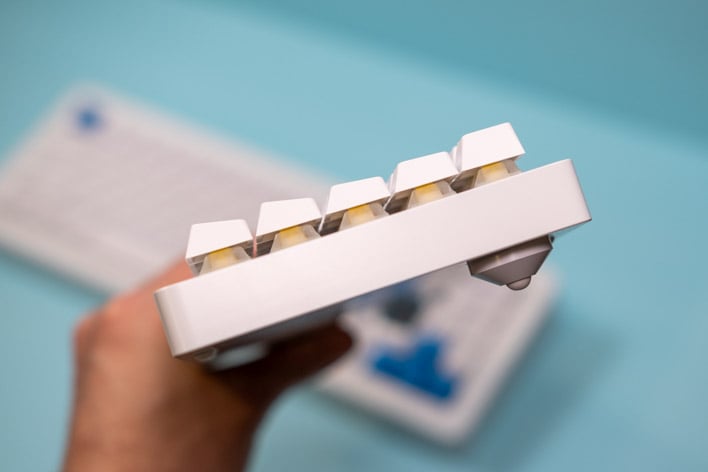WhiteFox Eclipse Mechanical Keyboard Review: A Modular Magnetic Marvel
The WhiteFox Eclipse Mechanical Keyboard Is A Solid Evolution Of A Classic Design
| WhiteFox Eclipse Mechanical Keyboard: Starting at $140 The WhiteFox Eclipse is a beautiful, mechanical keyboard with hot-swappable switches and an innovative modular design.
|
|||

|

|
||
That original WhiteFox was one of the first keyboards that I ever built. It required soldering and some tricky assembly, but you won't have to go to any particular trouble with the WhiteFox Eclipse. This keyboard is designed to be ready to use right out of the box with no assembly or modding required. Plus, it offers impressive customization not just of the firmware, but of the hardware as well.
WhiteFox Eclipse Design And Features
The WhiteFox Eclipse has an unusual layout. Previous incarnations of the WhiteFox were 65% boards, which is fairly common today thanks in large part to the impact of the original WhiteFox. The WhiteFox Eclipse adds a second column on the right side, but there's still no function row on the top, so this is a roughly 70% layout.With the extra keys, you should be able to access most common commands on the WhiteFox Eclipse without resorting to function layers. Plus, all the key sizes are standard. That means you can easily swap out the included keycaps with another set of your choosing. The stock keycaps are pretty good, though. They're thick PBT plastic with dye-sublimated legends that won't fade. It's a simple black on white affair, but there are a few optional blue accent keys. We'd like to see a few more keycaps included with the board, particularly for the right side columns, becuase if you want to change up the layout, you may end up with non-matching legends.
Unlike the WhiteFox of old, the Eclipse is a retail product that arrives fully assembled with pre-lubricated Gateron Yellow linear switches. It's a hotswap board, so you can yank those switches out and replace them with whatever you want. And if you want to tinker with that unusual layout, the board has full support for QMK and Via, the preferred firmware for custom keyboards.
What really sets the WhiteFox Eclipse apart, however, is the modular design. The case is held together by very strong magnets—you can flip the board over and shake it, and the magnets won't let go. When you grab the case and give it a firm tug though, it comes right apart. It takes all of 10 seconds to disassemble this keyboard, and half of that is fiddling with the battery cable. The board comes in one of three flavors: low-profile plastic ($140), low-profile aluminum ($225), and high-profile aluminum ($315). The cases are all plain white (e-coated in the case of the aluminum boards), and they look nice in an understated way. Keep in mind, there's no cheaper barebones option without switches or keycaps.
All three versions have the same "core" keyboard inside, consisting of the plate, PCB, silencing foam, keycaps, and switches. The gaskets are well-distributed around the case, so there's no mushiness like we saw with the OnePlus keyboard. The designers say the three current case options are just the first parts of an ecosystem for the WhiteFox. So far, we've only been able to experiment swapping the board between similar cases, but there's a lot of potential here, given how easy it is to disassemble the keyboard.
Since the core keyboard is identical for all three versions, you get the same connectivity options. There's a single USB-C port on the top left to plug into a PC. This also charges the internal 4,000mAh battery for Bluetooth. To program the WhiteFox, you can head over to the Via website in Chrome (required) and load the web app. Via is a fully visual editor, so there's almost no learning curve. Just click a key, select a function, install the new firmware, and it's done.
WhiteFox Eclipse Typing Experience
I consider myself a pretty big mechanical keyboard nerd—I own about 40 of them. Getting that deep into any hobby, you begin to focus on small details that a casual user would never notice. I want my typing to sound and feel a certain way, so I rarely use retail keyboards. However, I was pleasantly surprised when I started using the WhiteFox Eclipse.The board has been designed with its sound and feel in mind. The stock switches are pre-lubed linears, so they're nice and quiet, and the board itself has rubbery gaskets and silencing pads to eliminate rattle and vibration. The stabilizers (wires that run under longer keys) on many retail keyboards are rattly and terrible, but the WhiteFox's stabilizers are whisper quiet and pretty smooth. Even as picky as I am, I didn't feel the need to swap anything or lubricate moving parts.
There are RGB LEDs hiding under the keycaps of this board, plus some lights on the bottom row to indicate status. Those LEDs will clue you into charging and Bluetooth connection statusas well. I appreciate having a physical switch for the wireless functionality. Too many keyboards use esoteric key combinations to switch modes, but just flip the switch and the WhiteFox is ready to connect.
Bluetooth connectivity for custom keyboards is often buggy. The open source QMK firmware doesn't have native BT support, so every OEM has to add that on top. The WhiteFox Eclipse, however, is reliable, quick to reconnect, and has battery life measured in weeks. The only issue we encountered was a short BT timeout of just 5 minutes, but a firmware update boosted that to 20 minutes. We definitely like to see that kind of ongoing support for a product that costs this much.
You might be wondering why you would pay $315 for the high-profile WhiteFox Eclipse when the cheaper boards have the same core keyboard module. It's about the typing feel. Larger, heavier cases muffle the pings and creaks of switches and stabilizers, and the heft of the case reduces the echoey quality some metal keyboards have. Plus, being heavy (5.2 lbs in this instance) keeps the board from sliding around while you're typing. These big, heavy aluminum cases add substantially to the cost of custom boards, and believe it or not, $315 for the high-profile WhiteFox Eclipse is a solid deal in this market. It's a much better deal than the HHKB Studio, for example.
I tested both high and low-profile versions of the board, and I'm rather smitten with the high-profile WhiteFox Eclipse. The typing experience is as good as some of my more expensive custom keyboards, but even the low-profile feels quite good. My only concerns with the low-profile version are the slightly increased noise and minor wobble from the magnetic feet. This is not something the average typist would notice, though.
WhiteFox Eclipse Conclusion: A Classic Reborn
The WhiteFox Eclipse as it exists today is good. The WhiteFox Eclipse is worth considering if you want a high-end keyboard without all the tedious assembly or waiting for lengthy pre-orders to ship. It looks and sounds great out of the box, and it's easy to customize. It costs a bit more than some retail boards we've covered, but it offers a lot.As for the ecosystem play, we don't know if that's going to pan out yet. There is potential for it to be very cool, though. One project mentioned on the product page is a lovely "Luna Rossa" red case with dolch-style keycaps designed by Matt3o, the creator of the original WhiteFox keyboard.
The modular design is slick, and we're impressed that you can disassemble the board so quickly. After fiddling with the WhiteFox Eclipse over a few weeks, the finish is looking a little worn on some interior surfaces, but that's not a deal breaker. Even if you get more WhiteFox cases in the future, it should hold up well with occasional swaps. Even if there are never any more WhiteFox cases you want, the design makes the board extremely easy to clean. You are cleaning your keyboard regularly, right?
The $315 high-profile WhiteFox may be a tough sell, even if it's actually a decent value in light of similar products. The good news is the low-profile cases are also very nice, and they're much more affordable. The modular nature means you can get started with a cheaper $140 WhiteFox and potentially buy more enclosures down the line, assuming the ecosystem fills out. All three versions of the WhiteFox are available now from the project's retail partner Apos.



